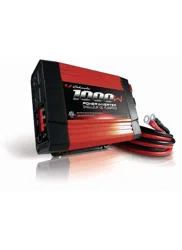Loading ...
Loading ...
Loading ...

• 8 •
4. Afx one or several “Ferrite Data Line Filters” to the television power cord. Ferrite Data
Line Filters can be purchased at most electronic supply stores.
5. Try grounding the inverter with a minimum 18 gauge (AWG) (0.75mm
2
) wire, using as
short a length as possible.
NOTE: You may hear a “buzzing” sound being emitted from inexpensive sound systems
when operated with the inverter. This is due to ineffective lters in the sound system’s
power supply. Unfortunately, this problem can only be resolved by purchasing a sound
system with a higher quality power supply or higher quality lter.
7. POWER SOURCE
When operating a device that draws approximately 60 watts, your average automobile
or marine battery at full charge will provide an ample power supply to the inverter for
approximately 3 hours when the engine is off. The actual length of time the inverter will
function depends on the age and condition of the battery and the power demand being
placed by the device being operated with the inverter.
If you decide to use the inverter while the engine is off, we recommend you turn OFF the
device plugged into the inverter before starting the engine. To maintain battery power, start
the engine regularly and let it run for approximately 15 to 20 minutes to recharge the battery.
Although it is not necessary to disconnect the inverter when turning over the engine, it may
briey cease to operate as the battery voltage decreases. While the inverter draws very
low amperage when not in use, it should be unplugged to avoid battery drain.
8. LED INDICATOR AND SHUTDOWN PROTECTION
The LED lights automatically when plugged into a 12 volt DC power source, but will not
light under the following conditions:
1. When the power input from the vehicle’s battery drops to approximately 10.5 volts,
low battery shutdown occurs and the inverter shuts off.
Solution: Recharge or Replace the battery.
2. When the power input from the vehicle’s battery exceeds 15 volts, high voltage
overload protection occurs.
Solution: Reduce the voltage range to between 12 volts and 14 volts.
3. The continuous load demand from the equipment or device being operated exceeds
the continuous load rating of the inverter being used.
Solution: Use a higher capacity inverter or lower rated device.
4. The case temperature becomes hot (exceeds 145°F).
Solution: Allow the inverter to cool. Do not block the cooling slots or air ow over and
through the inverter. Reduce the load on the inverter to the continuous rated output.
RESET: To reset after shutdown occurs, press the On/Off button to turn the inverter OFF.
Check the source of the problem and correct. Press the On/Off button to turn the inverter ON.
9. LED DISPLAY
The LED display identies the current status of the inverter.
VOLTS IN: The voltage of the vehicle’s battery, portable power jump starter or DC power
source.
WATTS: The power or wattage supplied to the device plugged into the inverter.
NOTE: The tolerance of the display is ± 15% when the output power is higher than 200 watts.
An audio alarm will sound when any of the following codes display. To stop the alarm,
press the On/Off switch:
•OUP – The vehicle’s battery voltage is between 15 and 16 volts. The inverter will
automatically restart after the voltage drops below 15.0 volts.
•OLP – The continuous load demand from the device exceeds the inverter’s wattage output.
•OCP – The inverter is overheated and automatically turns off for a period of 1 to 3 minutes
to cool. Make sure the inverter is well ventilated. It will automatically restart after it cools.
•LUP – Low Voltage Alarm. The vehicle’s battery voltage is between 10.7 and 11.3 volts.
•LUP – Low Voltage Shutdown. The vehicle’s battery voltage is between 10.2 and 10.8 volts.
•OPP – Short circuit, power surge or overload in the device.
Loading ...
Loading ...
Loading ...
